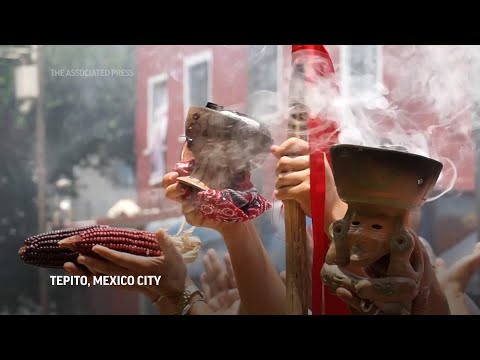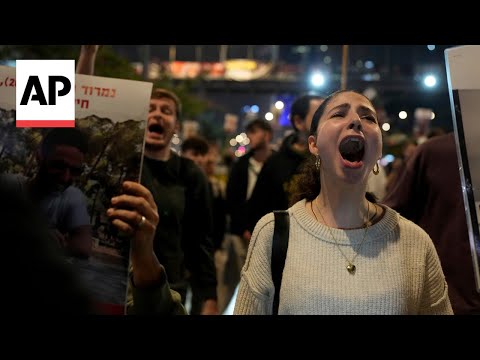(14 Aug 2024)
RESTRICTION SUMMARY:
ASSOCIATED PRESS
Mexico City, Mexico – 13 August 2024
1. Various of people holding incense and purple and red varieties of maize
2. People partaking in ceremony to commemorate Indigenous resistance at the atrium of a church
3. SOUNDBITE (Spanish) Claudia Santos, believer of Mexica Indigenous tradition:
++ SOUNDBITE PARTIALLY OVERLAID WITH SHOTS 2-6 ++
"After 503 (since colonization) we have reinterpreted our history, this being the Mexica tradition and beliefs. This is the moment and resurgence of our tradition, of our several native tribes and original townships. This is why it is important to make this kind of work to honor our grandfather Cuauhtemoc. This is why we are here, resisting."
4. Claudia Santos, believer in portraying a Mexica tradition, prepares the offering for the commemoration of the Day of Indigenous Resistance
5. Figurine of last Mexica emperor, Cuauhtemoc
6. Offering with fruits and mockup of a Mexica high-class warrior helmet
7. Various of Santos perfuming Franco Armenta, with copal incense, Armenta dressed up as a Mexica Eagle-warrior
8. People dancing to drums
9. Armenta leading ceremony, speaking in Nahuatl language
STORYLINE:
Claudia Santos’ spiritual journey has left a mark on her skin.
Soon after the 50-year-old embraced her pre-Hispanic heritage and pledged to speak for her ancestors’ worldview in Mexico City, she tattooed the symbol “Ollin” — which translates from Nahuatl as “movement” — on her wrist.
Santos was dressed in white and feathers hanging from her neck, ahead of the ancestral Mexica ceremony that she performed on Tuesday in the neighborhood of Tepito.
Since 2021, when she co-founded an organization that raises awareness on her community’s Mexica heritage, Santos and members of close indigenous communities gather in mid-August to honor Cuauhtémoc, who was the last emperor or “tlatoani” of Mexico-Tenochtitlan — as the capital was known — before the city fell to the Spaniards in 1521.
"After 503 (since colonization) we have reinterpreted our history, this being the Mexica tradition and beliefs. This is the moment and resurgence of our tradition, of our several native tribes and original townships,"Santos said about the neighborhood, which is one of oldest in the Mexican capital.
The site that she chose for performing the ceremony has a profound sacred meaning in Mexico’s history.
Though it’s currently a Catholic church, it’s also the site where Cuauhtémoc — not only a political, but a spiritual leader — initiated the final defense of the territory that was lost to the European conquerors.
Santos explained that the site where the church now stands is aligned with the sun.
Though he was not present during the pre-Hispanic rituals, the priest in charge of this Tepito church allowed Santos and fellow Indigenous leaders to move freely through the esplanade of the temple. Mornings start early, preparing the terrain by carefully placing roses, fruit, seeds and sculptures of pre-Hispanic figures among other elements.
Before Tuesday’s ceremony, as this year’s activities were inaugurated on August 9, a Mayan spiritual guide was also invited to perform a ritual at the church’s main entrance.
Gerardo Luna, the Mayan leader offered honey, incense, sugar, liquor, candles and other elements as a nourishment for the fire.
Feeling curious by the sound of a conch shell that was blown to announce the rituals and the smoke released by the lightning of a resin known as “copal,” some locals approached the church and joined both Mayan and Mexica ceremonies.
Find out more about AP Archive: http://www.aparchive.com/HowWeWork
Twitter: https://twitter.com/AP_Archive
Facebook: https://www.facebook.com/APArchives
Instagram: https://www.instagram.com/APNews/
You can license this story through AP Archive: http://www.aparchive.com/metadata/youtube/f3203cf69b6c4a7683c28d1681c98a3c
Author: AP Archive
Go to Source
News post in August 19, 2024, 3:04 pm.
Visit Our Sponsor’s:
News Post In – News





